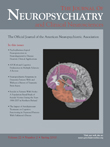Dr. Gupta Replies
We appreciate the issues raised by Dr. Segers. 1 We also agree that there are no uniformly accepted criteria for the Charles Bonnet syndrome as they have mentioned and literature differs in the presentation of the cases. In our manuscript, we have described the behavioral response of the patient to the visual hallucinations. 2 Negative or positive emotional reactions to the Charles Bonnet syndrome have been described in the past also. 3 – 5 However, literature is silent about the emotional and behavioral aspects of the Charles Bonnet syndrome and emphasizes only upon the preserved insight. 6 – 8 There is ample literature to suggest that behavior and emotions are intimately related though they may also be affected by cognitive processes, especially in humans. 9 Despite extensive literature search, we could not find any literature describing behavioral responses to hallucinations (with preserved insight) in Charles Bonnet syndrome. Preserved insight is a cognitive process which does not have entire control of the behavior, especially in the presence of negative emotions. 9 Hence, we feel that it is extremely difficult to differentiate “true” Charles Bonnet syndrome from complex visual hallucinations with the presently available information and further research is required.
1. Segers: Insight in true Charles Bonnet syndrome (letter). J Neuropsychiatry Clin Neurosci 2010 Spring; 22(2):247.e1 (published online May 2010)Google Scholar
2. Gupta R, Singhal A, Goel D, et al: Charles Bonnet syndrome: two case reports. J Neuropsychiatry Clin Neurosci 2008; 20:377Google Scholar
3. Teunisse RJ, Cruysberg JR, Hoefnagels WH, et al: Visual hallucinations in psychologically normal people: Charles Bonnet syndrome. Lancet 1996; 347:794–797Google Scholar
4. Holroyd S, Rabins PV, Finkelstein D, et al: Visual hallucinations in patients from an ophthalmology clinic and medical clinic population. J Nerv Ment Dis 1994; 182:273–276Google Scholar
5. Brown GC, Murphy RP: Visual symptoms associated with choroidal neovascularization, photopsias and the Charles Bonnet syndrome. Arch Ophthalmol 1992; 110:1251–1256Google Scholar
6. Sims A: Symptoms in Mind, 3rd edition. Delhi, India, Reed Elsevier India, 2003Google Scholar
7. Casey P, Kelly B: Fish’s clinical psychopathology. Delhi, India, Jaypee Brothers Medical Publishers, 2007Google Scholar
8. Lishman WA: Organic Psychiatry. Oxford, UK, Blackwell Scientific Science, 1998Google Scholar
9. Easterbrook JA: The effect of emotion on cue utilization and organization of behavior. Psychol Rev 1959; 66:183–201Google Scholar



